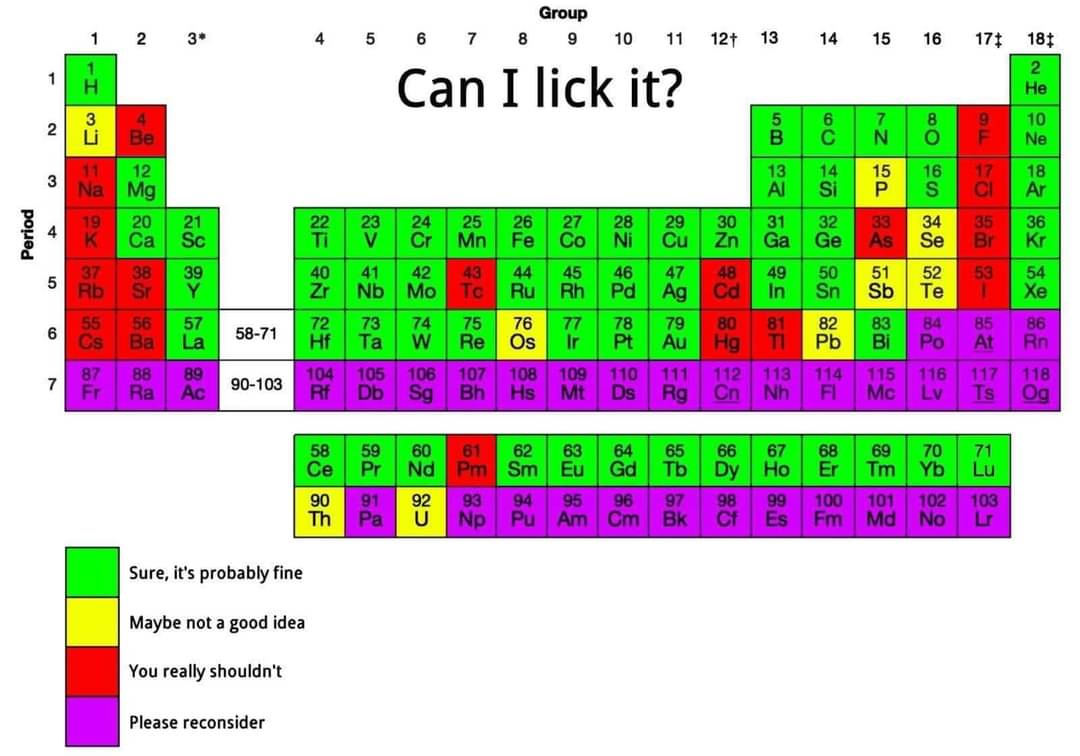They're all lickable, it's just that some you can only lick once.
Science Memes
Welcome to c/science_memes @ Mander.xyz!
A place for majestic STEMLORD peacocking, as well as memes about the realities of working in a lab.

Rules
- Don't throw mud. Behave like an intellectual and remember the human.
- Keep it rooted (on topic).
- No spam.
- Infographics welcome, get schooled.
Research Committee
Other Mander Communities
Science and Research
Biology and Life Sciences
- !abiogenesis@mander.xyz
- !animal-behavior@mander.xyz
- !anthropology@mander.xyz
- !arachnology@mander.xyz
- !balconygardening@slrpnk.net
- !biodiversity@mander.xyz
- !biology@mander.xyz
- !biophysics@mander.xyz
- !botany@mander.xyz
- !ecology@mander.xyz
- !entomology@mander.xyz
- !fermentation@mander.xyz
- !herpetology@mander.xyz
- !houseplants@mander.xyz
- !medicine@mander.xyz
- !microscopy@mander.xyz
- !mycology@mander.xyz
- !nudibranchs@mander.xyz
- !nutrition@mander.xyz
- !palaeoecology@mander.xyz
- !palaeontology@mander.xyz
- !photosynthesis@mander.xyz
- !plantid@mander.xyz
- !plants@mander.xyz
- !reptiles and amphibians@mander.xyz
Physical Sciences
- !astronomy@mander.xyz
- !chemistry@mander.xyz
- !earthscience@mander.xyz
- !geography@mander.xyz
- !geospatial@mander.xyz
- !nuclear@mander.xyz
- !physics@mander.xyz
- !quantum-computing@mander.xyz
- !spectroscopy@mander.xyz
Humanities and Social Sciences
Practical and Applied Sciences
- !exercise-and sports-science@mander.xyz
- !gardening@mander.xyz
- !self sufficiency@mander.xyz
- !soilscience@slrpnk.net
- !terrariums@mander.xyz
- !timelapse@mander.xyz
Memes
Miscellaneous
Ah, a modest variation of the mushroom forager's creed
My pet peeve is when people say "everything is edible once" instead of "eatable". No, everything is not edible once, that's the point of the word!
Lickable though, now we're in business.
My lead sandwich is calling to me
Mmm Pb&J.
You can't lick Titanium?
Titanium (22) is save to lick. Enjoy!
It is so safe to lick that it is used in dental and bone implants! Very lickable element.
Ahh I saw Tl and mistake it as Ti XD
I had to look it up as well ;)
Please don't lick elemental hydrogen.
Out of curiosity, what would happen if you do?
In the hypothetical, if one were able to lick elemental hydrogen in its atomic, rather than molecular form, it would have a few potential effects. The one that would concern me most would be its aggressive reactivity, ripping hydrogens away from anything that it could in order to achieve stability. This would potentially cause tissue damage both from the deprotonation and shift in pH.
What would cause the shift in pH? The atomic hydrogen would rip off H· radicals, not H^+^ ions.
It would be more likely a secondary or tertiary effect. That is, H• radicals ripped away from their parent molecules would leave •OH, •R, and •RNH radicals. These are unstable and highly reactive, "desiring" to have that stable electron configuration. Likely, this will result in electrons being shifted to bring in more stable species, like OH-. Overall, we're looking at effectively a deprotonation of the saliva, with extra intermediary steps to stabilize the radicals.
Interesting. Given that H• is a neutral species, what would cause the preference for the creation of stable negative species (freeing up H+) over the creation of stable positive species (freeing up OH-)?
Neutral as far as pH is concerned, yes. However, radicals tend to be very reactive due to their valance not being full. I am a bit rusty, TBH, as I'm about a decade and a half out of uni but, the best way to predict the products of the reaction is to look at the high-level of the equation:
H• (excess) + H••OH + H••R + H••N-R -> H2(g) + •OH + •R + •N-R
All of the products of the initial reaction here are radicals except for the H2 molecules. They all are going to further react to form more stable species with full valances, with possible exception being the molecular hydrogen. Because the elemental hydrogen is introduced as a radical rather than protons (H+ ions) in the solution, the final products are likely to be more negatively charged, neutral, and/or have some interesting hydrogen additions, especially in the hydrocarbons and amino acids.
For example, there could be reactions like:
R• + •OH + •N-R -> R-OH + HO-N-R
Overall, however, the amount of free hydrogen/protons is likely to be reduced as they are effectively removed from solution as hydrogen gas.
Because the elemental hydrogen is introduced as a radical rather than protons (H+ ions) in the solution, the final products are likely to be more negatively charged
This is the part I don't understand. If charge is conserved, why would there be a preference for a particular charge in the products?
No. I think that you're absolutely correct. The products should have charge conserved. After initial attack of hydrocarbons by H• radicals, H2 is likely to be a significant product. Supposing STP, it would likely remove itself from solution, leaving the fresh radicals to chain react and probably making interesting and unhealthy things.
My apologies, I'm out of the lab and field 15 years now so, do make some pretty basic mistakes at times.
After initial attack of hydrocarbons by H• radicals, H2 is likely to be a significant product. Supposing STP, it would likely remove itself from solution, leaving the fresh radicals to chain react and probably making interesting and unhealthy things.
That makes sense.
My apologies, I’m out of the lab and field 15 years now so, do make some pretty basic mistakes at times.
No worries! I've enjoyed this discussion!
